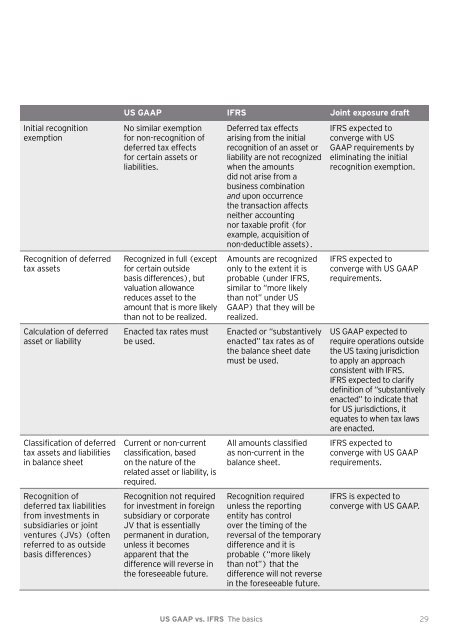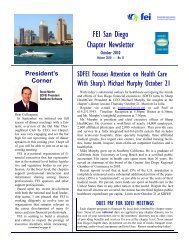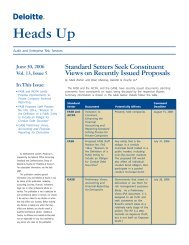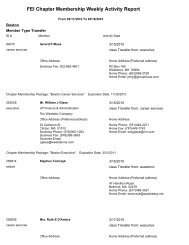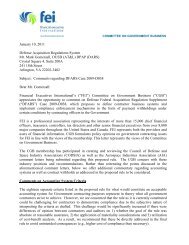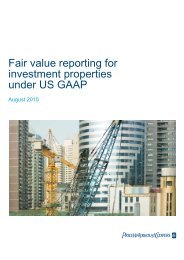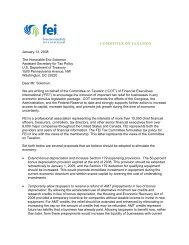US GAAP vs. IFRS The basics - Financial Executives International
US GAAP vs. IFRS The basics - Financial Executives International
US GAAP vs. IFRS The basics - Financial Executives International
You also want an ePaper? Increase the reach of your titles
YUMPU automatically turns print PDFs into web optimized ePapers that Google loves.
Initial recognition<br />
exemption<br />
Recognition of deferred<br />
tax assets<br />
Calculation of deferred<br />
asset or liability<br />
Classification of deferred<br />
tax assets and liabilities<br />
in balance sheet<br />
Recognition of<br />
deferred tax liabilities<br />
from investments in<br />
subsidiaries or joint<br />
ventures (JVs) (often<br />
referred to as outside<br />
basis differences)<br />
<strong>US</strong> <strong>GAAP</strong> <strong>IFRS</strong> Joint exposure draft<br />
No similar exemption<br />
for non-recognition of<br />
deferred tax effects<br />
for certain assets or<br />
liabilities.<br />
Recognized in full (except<br />
for certain outside<br />
basis differences), but<br />
valuation allowance<br />
reduces asset to the<br />
amount that is more likely<br />
than not to be realized.<br />
Enacted tax rates must<br />
be used.<br />
Current or non-current<br />
classification, based<br />
on the nature of the<br />
related asset or liability, is<br />
required.<br />
Recognition not required<br />
for investment in foreign<br />
subsidiary or corporate<br />
JV that is essentially<br />
permanent in duration,<br />
unless it becomes<br />
apparent that the<br />
difference will reverse in<br />
the foreseeable future.<br />
<strong>US</strong> <strong>GAAP</strong> <strong>vs</strong>. <strong>IFRS</strong> <strong>The</strong> <strong>basics</strong><br />
Deferred tax effects<br />
arising from the initial<br />
recognition of an asset or<br />
liability are not recognized<br />
when the amounts<br />
did not arise from a<br />
business combination<br />
and upon occurrence<br />
the transaction affects<br />
neither accounting<br />
nor taxable profit (for<br />
example, acquisition of<br />
non-deductible assets).<br />
Amounts are recognized<br />
only to the extent it is<br />
probable (under <strong>IFRS</strong>,<br />
similar to “more likely<br />
than not” under <strong>US</strong><br />
<strong>GAAP</strong>) that they will be<br />
realized.<br />
Enacted or “substantively<br />
enacted” tax rates as of<br />
the balance sheet date<br />
must be used.<br />
All amounts classified<br />
as non-current in the<br />
balance sheet.<br />
Recognition required<br />
unless the reporting<br />
entity has control<br />
over the timing of the<br />
reversal of the temporary<br />
difference and it is<br />
probable (“more likely<br />
than not”) that the<br />
difference will not reverse<br />
in the foreseeable future.<br />
<strong>IFRS</strong> expected to<br />
converge with <strong>US</strong><br />
<strong>GAAP</strong> requirements by<br />
eliminating the initial<br />
recognition exemption.<br />
<strong>IFRS</strong> expected to<br />
converge with <strong>US</strong> <strong>GAAP</strong><br />
requirements.<br />
<strong>US</strong> <strong>GAAP</strong> expected to<br />
require operations outside<br />
the <strong>US</strong> taxing jurisdiction<br />
to apply an approach<br />
consistent with <strong>IFRS</strong>.<br />
<strong>IFRS</strong> expected to clarify<br />
definition of “substantively<br />
enacted” to indicate that<br />
for <strong>US</strong> jurisdictions, it<br />
equates to when tax laws<br />
are enacted.<br />
<strong>IFRS</strong> expected to<br />
converge with <strong>US</strong> <strong>GAAP</strong><br />
requirements.<br />
<strong>IFRS</strong> is expected to<br />
converge with <strong>US</strong> <strong>GAAP</strong>.<br />
29


